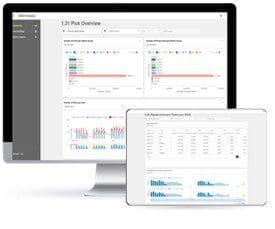
Peaks are all so different
During the summer months, in one sector the demand for sun cream explodes while in another, it’s the demand for mineral water. Everyone is familiar with such seasonal demands. The result is often a peak sales volume for a specific group of items. The good news is that these peaks come at about the same time every year and can therefore be easily planned for.
Todays’ influencer community also has a huge impact on the plannability of goods and on the delivery performance. When a photo of an important influencer wearing a specific outfit, glasses or jewelry goes online, demand for the item may spike. This type of peak, however, can also easily be managed. The hype usually revolves around just one item and can easily be managed by a modern logistics system.
But what really gets the supply chain and warehouse managers in a sweat are extremely intense sales days or weeks such as the well-known Black Friday or Cyber Monday. These are the top drivers of peaks, and all involve e-commerce. They are responsible for record turnovers in very different sectors around the world. Here, it’s extremely difficult to predict which sales volume will be reached for which goods.
Balancing the workload – the real challenge
Imagine a warehouse operating around the clock, 360 days a year. This warehouse runs at a perfect optimum with fixed capital in the form of inventory balanced perfectly with sales and purchasing, and all the items perfectly distributed to the various storage areas of the warehouse. The warehouse technologies for manual, semi- or fully automatic solutions are perfectly balanced, and all processes run smoothly. Suddenly, the situation changes, whether because of a new company strategy, ever-present retail dynamics or possibly due to a completely new influencing factor. During periods of normal business, this means that our optimized warehouse only needs to perform at its highest level for a short period of time. In some circumstances, however, we may be forced to make significant changes to our optimum.
How can we rapidly bring our logistics operation up to its full speed during such a peak?
Logistics software is your ace in the hand, before, during and after the peaks
Sophisticated transport networks are great in logistics, but the bottom line is how quickly an order gets moved through a warehouse. That’s why the order lead time is such an important key figure for evaluating how well a particular warehouse location has performed during a peak period. These key figures can be determined and used to help establish the right conditions to shorten lead times. The truth is, the faster an order leaves the warehouse, the more orders can be processed within this period.
In this context, the magic words are clear logistics data and integrated software systems. These contribute significantly to optimal order processing and therefore to the successful management of peak periods. Analyses, configurations and resources are our main parameters to tweak the system.

Before the peaks – using data analytics to make the right decisions
Both predictive and retrospective data analyses are key in making fundamental decisions and defining logistics strategies. Complete transparency is the main advantage of having fully integrated software systems in a logistics installation. With analytics, you have a firm foundation of data, facts and figures from previous periods to draw upon for planning. They can reveal any weak points in the logistics installation, such as unplanned replenishment from overstock to the picking area, or failure of mechanical components, and allow you to take measures to correct the problem before things get out of hand.
The advantage of data transparency becomes even more evident if you compare it to how things used to be done, using lists and depending on gut feelings. The data can be used to make a precise forecast. Based on this calculation, parameters are set to ensure the best possible conditions for peaks. These parameters might be of a logistic nature, for example, the ABC classification of goods. They might also affect the technologies or resources. For example, you can define the necessary servicing work for each machine to prevent failures, or schedule personnel so that the right employees are available.
WMS and WCS to implement a strategy for the peaks
Once a strategy is defined and decisions are made about logistical, technical and resource relevant parameters, the warehouse management system (WMS) and warehouse control system (WCS) put these into practice. When necessary, a fully integrated system with a basis of analytics data can also automatically make adjustments. This is mainly about the decisions that are made based on the ABC classification regarding the most suitable storage location for certain goods in the warehouse. The forecast data for a specific period determines an expected sales volume, which then determines the respective quantity of these goods.
Each process required in the warehouse – from goods-in to quality control intervals to replenishment – is then finely adjusted through configuration. Unplanned replenishment of the picking area from overstock costs time and should be avoided. Making these fine adjustments results in a warehouse that can cope with most of the challenges associated with a peak. All the goods are actually there where they are needed. At the same time, the flow of goods not involved in the peak must not be negatively influenced. What we are doing, is building an additional logistic high-speed line through the warehouse for a specific period. Intelligent warehouse management and control systems help keep the traffic organized, flowing and stable.
Operational excellence systems for the best use of the human resource
Your optimized system has the goods stored at the optimal location, replenished in the best warehouse area and, where needed, given the right check. Optimal staffing is the next element needed and is just as important as maintaining that all-important stock. For peak periods, this means having your employees at the right work stations and equipped with the right tools needed to guarantee that the order lead time hits the calculated optimum. This also means properly utilizing your employees that have special training and expertise. Operational excellence systems support the warehouse manager in choosing the most efficient and effective employees for each activity based on their skills and experiences. If you have a fully integrated product for this area, you can also see from the WMS/WCS which processes are active at the work stations. From this data, you can determine which employees you need. Here is an example: Three quality check stations are active in the morning which means three employees with quality check skills are required for the first shift.
Get your logistics installation in top form with CMMS
Everything is prepared. Your employees are motivated and at their work stations, and the goods are stored optimally at the right location and in the right quantity and quality. The first orders can be processed but, suddenly, the mechatronics throw a wrench in the works. Just as regular servicing is a must for the latest and best car, regular servicing is also a must for warehouse installations. Thanks to CMMS, which is short for Computerized Maintenance Management System, data analyses determine exactly when each piece of equipment must be inspected. Here are just some of the questions that have to be answered: Is servicing due? For how many hours has the motor been running? When was the printer last checked? This electronic watchdog prevents unpleasant surprises and this is urgently needed. Each machine that suddenly fails, even the smallest component such as a printer, or a small problem at the goods-in dock of all places, can lead to delays in a high-speed line. An intelligent CMMS can prevent delays like these.
Conclusion: Intelligent logistics software successfully guides you through each peak
Transparent data from analytics systems helps you find the strategies necessary for mastering the peak workloads of the peak periods. Past experiences are used in addition to what the forecast says about the volumes that are expected to come in for processing. The warehouse management and control systems implement the derived strategies in the form of system configurations and system parameters to reach the expected result. As soon as the warehouse management and control systems are set up with stock and warehouse modelling, a plan for the personnel is created. Here, resource management gets the job done. Once our motivated employees are ready to go, the CMMS checks for any machine inspection or servicing requirements to keep everything running smoothly.
Thanks to all the possibilities provided by logistics software these days, we can now be perfectly prepared for the next peak period, releasing the full potential of the warehouse. A glance at the future reveals that by adding machine learning and artificial intelligence, there is still quite a bit of room for even more improvement.
**
 Martina Schwinger, Portfolio Manager, at KNAPP for Software & IT, is responsible for implementing the software strategy and IT solutions. During the past 20 years at KNAPP, she has taken on a variety of different roles for the subsidiaries of the KNAPP group. Her focus has always been on software and IT. During this time, her leadership and hands-on commitment to international logistics projects gave her the opportunity to put different logistic and strategic approaches to the test. As a certified logistical consultant and by continuing her education in logistics software & IT , Martina keeps in step with the times.
Martina Schwinger, Portfolio Manager, at KNAPP for Software & IT, is responsible for implementing the software strategy and IT solutions. During the past 20 years at KNAPP, she has taken on a variety of different roles for the subsidiaries of the KNAPP group. Her focus has always been on software and IT. During this time, her leadership and hands-on commitment to international logistics projects gave her the opportunity to put different logistic and strategic approaches to the test. As a certified logistical consultant and by continuing her education in logistics software & IT , Martina keeps in step with the times.
















 There’s a new reason to optimize DC operations, and it’s bigger than the old reasons of productivity and efficiency gains. More and more companies are realizing that investing in their DCs and powering them with modern and sophisticated technologies like AI can lead to competitive advantages for the overall company.
There’s a new reason to optimize DC operations, and it’s bigger than the old reasons of productivity and efficiency gains. More and more companies are realizing that investing in their DCs and powering them with modern and sophisticated technologies like AI can lead to competitive advantages for the overall company. Ken Ramoutar is CMO at
Ken Ramoutar is CMO at 